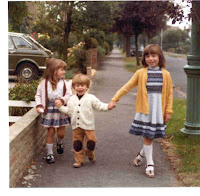Perhaps there is a time and place for every book. Some are instant successes while others are discovered and appreciated or even become classics long after the author is deceased. Similarly, there is a time or place for a particular book in a reader’s life. For me, I should have read the one I recently finished, David McCullough’s “biography” of the Brooklyn Bridge (
The Great Bridge, 1972) when I lived in Brooklyn during the 1960’s. I say “biography” rather than history as after reading his work, it feels like a living, breathing bulwark, a creation for the ages, one that was built while New York was just beginning to become a vertical city. When it was built, its 275-foot towers dwarfed everything in New York and Brooklyn, except Trinity Church, the tallest structure in Manhattan when it was built in 1846, at 281 feet. But the bridge’s two towers are massive as well.

Over the years, New York, and Brooklyn, grew around the bridge, and by the time I lived in Brooklyn, to most New Yorkers it was just part of the skyline. Although I appreciated its architecture, particularly the few times I had crossed the bridge on its walkways, I confess I was somewhat oblivious to its extraordinary engineering (particularly for the time) and its intricate history.
After college in Brooklyn, I lived mostly in downtown Brooklyn, at 175 Willoughby Street and also at 234 Lincoln Place in the Park Slope section. After Chris was born in 1965, a favorite destination for a Sunday walk was the Brooklyn Heights Promenade, the Brooklyn Bridge rising majestically at the north end.
Oh, had McCullough’s magnificent history been written before then. I might have had a greater appreciation for how the bridge transformed the city and the engineering genius and architectural greatness of the structure. McCullough writes a biography as a novel, putting the reader into the times and the minds of the main characters. It is his later work, such as his Pulitzer Prize winning biography of John Adams that is leading me to his earlier histories. Here is his finely crafted description of the completed bridge, prose worthy of any novel: “The very shabbiness and stunted scale of the old neighborhood beneath the tower worked to the advantage of the bridge, which by contrast seemed an embodiment of the noblest aspirations, majestic, heaven-directed, lifting into the light above the racket, the shabbiness, and the confusion of the waterfront, the way a great cathedral rises over the hovels of the faithful. And the twin archways in the tower, seen from the street level, looked like vast vacant windows to the sky. For a child seeing it at night, the tower could have been the dark and mighty work of medieval giants. Where on earth could one see so many stars framed in granite?”
The building of the bridge is a microcosm of everything that is great and deplorable about mankind. John Roebling, a German born engineer and builder of The Roebling Suspension Bridge, spanning the Ohio at Cincinnati, completed plans for the Brooklyn Bridge but an accident led to his death before work commenced in 1869. His son, Washington Roebling, also an engineer, took over the plans and the responsibilities of the bridge, but during the construction of the massive foundations – to the depth of almost 45 feet on the Brooklyn side and 78 feet on the New York side – he suffered the effects of the bends from being in one of the huge caissons that had to be constructed and sunk for that purpose. As a consequence, he had a nervous condition and supervised the remaining construction from home on Brooklyn Heights. He did not even have the strength to attend the opening (his wife, Emily, was his steadfast emissary for such occasions). Meanwhile he had to contend with charges of kickbacks (his family owned one of the suppliers of steel cables) and a changing political scene ranging from Boss Tweed to various showdowns with politicians trying to grab headlines for themselves. He was even asked to resign at one point; he refused and insisted they (the Directors of the New York Bridge Company) fire him, which he knew they dared not. Throughout it all, he survived to build a bridge for the ages. It enjoyed its one-hundredth birthday anniversary in 1983. Engineers have estimated it could last another one hundred before the cables have to be replaced and if they are, perhaps the bridge will go on forever.
Although I still visit New York occasionally, I have no reason to go downtown, other than, now, traveling on the East River by boat. We brought our own boat up from the Chesapeake some fifteen years ago, passing under the Brooklyn Bridge with the World Trade Towers rising in the background. It would have been inconceivable that either landmark could be gone during my lifetime. But they both go on in my mind’s eye, with wonder.

.























